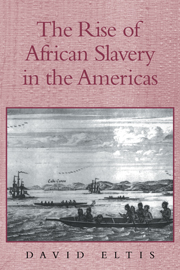Book contents
- Frontmatter
- Contents
- List of Tables
- List of Maps
- Preface
- Abbreviations
- Chapter 1 Slavery and Freedom in the Early Modern World
- Chapter 2 The English, the Dutch, and Transoceanic Migration
- Chapter 3 Europeans and African Slavery in the Americas
- Chapter 4 Gender and Slavery in the Early Modern Atlantic World
- Chapter 5 Productivity in the Slave Trade
- Chapter 6 Africa and Europe in the Early Modern Era
- Chapter 7 The African Impact on the Transatlantic Slave Trade
- Chapter 8 The English Plantation Americas in Comparative Perspective
- Chapter 9 Ethnicity in the Early Modern Atlantic World
- Chapter 10 Europe and the Atlantic Slave Systems
- Epilogue on Abolition
- Appendices
- Maps
- Sources and Bibliography
- Index
Chapter 7 - The African Impact on the Transatlantic Slave Trade
Published online by Cambridge University Press: 05 August 2012
- Frontmatter
- Contents
- List of Tables
- List of Maps
- Preface
- Abbreviations
- Chapter 1 Slavery and Freedom in the Early Modern World
- Chapter 2 The English, the Dutch, and Transoceanic Migration
- Chapter 3 Europeans and African Slavery in the Americas
- Chapter 4 Gender and Slavery in the Early Modern Atlantic World
- Chapter 5 Productivity in the Slave Trade
- Chapter 6 Africa and Europe in the Early Modern Era
- Chapter 7 The African Impact on the Transatlantic Slave Trade
- Chapter 8 The English Plantation Americas in Comparative Perspective
- Chapter 9 Ethnicity in the Early Modern Atlantic World
- Chapter 10 Europe and the Atlantic Slave Systems
- Epilogue on Abolition
- Appendices
- Maps
- Sources and Bibliography
- Index
Summary
The african capacity to influence the early modern Atlantic world is nowhere clearer than in the highly individualised regional diversity that developed in Afro-European relations. As long as Europeans wanted plantations in the seventeenth-century sense then, as in the Americas, the natural resource base of the continent would have a major influence over the geography of trade. But once Africans made it clear that Europeans could have no significant settlements and little political power, and once slaves became the dominant commodity, as in Africa by 1700, then trade should have followed the distribution of the population in Africa or perhaps wind and ocean currents in the Atlantic. In fact, European-African trade patterns were not consistent with these expectations. To explain the historical reality of trade, scholars must look beyond geophysical and narrowly economic factors. Physical and cultural anthropologists recognise that greater human diversity exists in Africa than in any other continent. Such diversity meant a wide variation in the human needs and preferences that provide the foundations of all trade and also, perhaps, helps explain the narrower concepts of insider that held in Africa compared to Europe.
Each segment of sub-Saharan Africa developed its modus vivendi with early modern Europeans. While all regions saw slaves emerge as the dominant export, each reached that point via a different route. Senegambia demonstrates this point best (see Map 2 in the map section following appendices).
- Type
- Chapter
- Information
- The Rise of African Slavery in the Americas , pp. 164 - 192Publisher: Cambridge University PressPrint publication year: 1999



